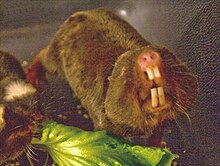Blesmol
This article needs additional citations for verification. (November 2007) |
| Blesmols Temporal range:
| |
|---|---|

| |
| Damaraland mole-rat | |
| Scientific classification | |
| Domain: | Eukaryota |
| Kingdom: | Animalia |
| Phylum: | Chordata |
| Class: | Mammalia |
| Order: | Rodentia |
| Parvorder: | Phiomorpha |
| Family: | Bathyergidae Waterhouse, 1841 |
| Type genus | |
| Bathyergus Illiger, 1811
| |
| Genera | |
| |
The blesmols, also known as mole-rats, or African mole-rats, are burrowing
Distribution
Modern blesmols are found strictly in sub-Saharan Africa. Fossil forms are also restricted almost exclusively to Africa, although a few specimens of the Pleistocene species Cryptomys asiaticus have been found in Israel.[1] Nowak (1999) also reports that †Gypsorhychus has been found in fossil deposits of Mongolia.
Anatomy
Blesmols are somewhat
The eyes of blesmols are structurally normal, despite their relatively small size, and include normal light-sensitive cells. However, the visual centres of their brains are reduced in certain respects, especially in those centres concerned with localising objects in the visual field. Research has shown that at least two species of blesmol (
Most blesmol species dig using their powerful
| Dentition |
|---|
| 1.0.2-3.0-3 |
| 1.0.2-3.0-3 |
Technical characteristics
The skull morphology of blesmols sets them apart from all other rodents. As with all members of
Behavior
Blesmols live in elaborate burrow systems and different species exhibit varying degrees of sociality. Most species are solitary, but one species, the
These animals prefer loose, sandy soils and are often associated with arid habitats. They rarely come to the surface, spending their entire life underground. Blesmols are herbivorous, and primarily eat roots, tubers, and bulbs. They are even able to pull smaller plants underground by their roots, without having to leave their burrows, enabling them to eat leaves, stems, and other parts of the plant that would otherwise be inaccessible. Blesmols burrow in search of food, and the great majority of their tunnel complex consists of these foraging burrows, surrounding a smaller number of storage areas, nests, and latrine chambers.[2]
Most species breed only once or twice during the year, although some breed all year round. They generally have small litters of two to five young, perhaps because their environment is sufficiently safe that they do not need to rapidly replace their population as many other rodents do. However, some species have much larger litters, averaging twelve young in the naked mole rat, and sometimes much larger.[2]
Classification
The Bathyergidae are monophyletic, with all taxa tracing back to a single common ancestor.[4] Although there is some controversy, the closest living relatives of the blesmols appear to be other African hystricognaths in the families Thryonomyidae (cane rats) and Petromuridae (dassie rats). Together these three living families along with their fossil relatives represent the infraorder Phiomorpha.[5]
At present 21 species of blesmols from 5 genera are accepted,
- Family Bathyergidae
- Subfamily Bathyerginae
- Georychus- cape blesmol
- Georychus capensis- cape mole-rat
- Cryptomys
- Cryptomys holosericeus - greater grey mole-rat [citation needed]
- Cryptomys hottentotus- common mole-rat
- Cryptomys mahali - Mahali mole-rat
- Cryptomys natalensis - Natal mole-rat [citation needed]
- Cryptomys nimrodi- Matabeleland mole-rat
- Fukomys
- Fukomys amatus- Zambian mole-rat
- Fukomys anselli- Ansell's mole-rat
- Fukomys bocagei- Bocage's mole-rat
- Fukomys damarensis- Damaraland mole-rat
- Fukomys darlingi- Mashona mole-rat
- Fukomys foxi- Nigerian mole-rat
- Fukomys ilariae[13] - Somali striped mole-rat
- Fukomys kafuensis- Kafue mole-rat
- Fukomys mechowii- Mechow's mole-rat
- Fukomys micklemi- Kataba mole-rat
- Fukomys ochraceocinereus- Ochre mole-rat
- Fukomys whytei - Malawian mole-rat [citation needed]
- subspecies: F. w. occlusus
- Fukomys zechi- Ghana mole-rat
- Heliophobius- Silvery mole-rat
- Heliophobius argenteocinereus- Silvery mole-rat
- Bathyergus - Dune blesmols
- Bathyergus janetta- Namaqua dune mole-rat
- Bathyergus suillus- Cape dune mole-rat
- Subfamily Bathyerginae
Citations
- ISBN 0-8165-1100-4.
- ^ ISBN 0-87196-871-1.
- PMID 20676369.
- S2CID 23091402.
- ISBN 0-8160-1194-X.
- ^ PMID 15120397.
- ^ hdl:11336/85874.
- ^ Numbers of species and genera from the preceding sources have been adjusted to reflect the removal of Heterocephalus to family Heterocephalidae.
- S2CID 24040671.
- .
- ISBN 978-0691164533.
- ISBN 978-8494189234.
- .
References
- Kingdon, J. 1997. The Kingdon Field Guide to African Mammals. Academic Press Limited, London.
- McKenna, M.C. and S. K. Bell. 1997. Classification of Mammals above the Species Level. Columbia University Press, New York.
- Nowak, R. M. 1999. Walker's Mammals of the World, Vol. 2. Johns Hopkins University Press, London.
- Seney ML, Kelly DA, Goldman BD, Šumbera R, Forger NG (2009) Social Structure Predicts Genital Morphology in African Mole-Rats. PLoS ONE 4(10): e7477. doi: 10.1371/journal.pone.0007477. Figure
- Mitgutsch, C., Richardson, M. K., Jiménez, R., Martin, J. E., Kondrashov, P., de, B. M. A., & Sánchez-Villagra, M. R. (January 1, 2012). Circumventing the polydactyly 'constraint': the mole's 'thumb'. Biology Letters, 8, 1, 74–7.
